St. Patrick's Cathedral, New York
| Saint Patrick's Cathedral, New York | |
|---|---|
| U.S. National Register of Historic Places | |
| U.S. National Historic Landmark | |
 View of the cathedral from Rockefeller Center (September 2006).
|
|
| Location: | New York City, New York, United States |
| Coordinates: | |
| Area: | 2 acres (0.81 ha) |
| Built/Founded: | 1858-1878 |
| Architect: | James Renwick, Jr. |
| Architectural style(s): | decorated Neo-Gothic |
| Governing body: | Roman Catholic Archdiocese of New York |
| Added to NRHP: | December 8, 1976[1] |
| Designated NHL: | December 8, 1976[2] |
| NRHP Reference#: | 76001250 |
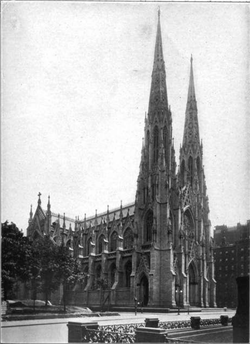
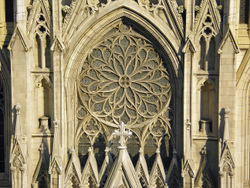
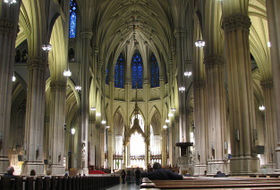
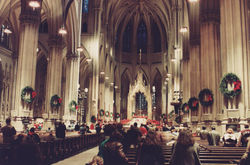
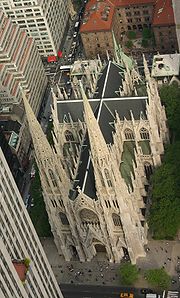
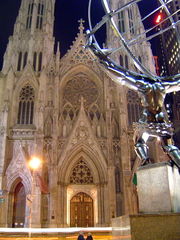
Saint Patrick's Cathedral is a decorated Neo-Gothic-style Roman Catholic cathedral church in the United States. It is the seat of the archbishop of the Roman Catholic Archdiocese of New York, and a parish church, located on the east side of Fifth Avenue between 50th and 51st Streets in midtown Manhattan, New York City, New York. It faces Rockefeller Center.
Contents |
History
Purchase of the property
The land on which the present cathedral sits was purchased for $11,000 on March 6, 1810, as a site for a school for young Roman Catholic men, the New York Literary Institution, to be conducted by the Jesuits. The school closed and was sold to the diocese. In 1814, the diocese gave use of the property to Dom Augustin LeStrange, abbot of a community of Trappists (from the original monastery of La Trappe) who came to America fleeing persecution by French authorities. In addition to a small monastic community, they also looked after some thirty-three orphans. With the downfall of Napoleon in that year, the Trappists returned to France, abandoning the property. The property at this point was designated for a future cemetery. The neighboring orphanage was maintained by the diocese into the late 1800s. Some of the Trappists resettled to Canada and eventually founded St. Joseph's Abbey in Spencer, Massachusetts.[3]
Construction of the cathedral
The Diocese of New York, created in 1808, was made an archdiocese by Pope Pius IX on July 19, 1850. In 1853, Archbishop John Joseph Hughes announced his intention to erect a new cathedral to replace the Old Saint Patrick's Cathedral in downtown Manhattan.[4]
The new cathedral was designed by James Renwick, Jr. in the Gothic Revival style. On August 15, 1858, the cornerstone was laid, just south of the diocese's orphanage. At that time, present-day midtown Manhattan was far north of the populous areas of New York City.
Work was begun in 1858 but was halted during the Civil War and resumed in 1865. The cathedral was completed in 1878 and dedicated on May 25, 1879, its huge proportions dominating the midtown of that time. The archbishop's house and rectory were added from 1882 to 1884, and an adjacent school (no longer in existence) opened in 1882. The towers on the west façade were added in 1888, and an addition on the east, including a Lady chapel, designed by Charles T. Mathews, was begun in 1901. The stained-glass windows in the Lady Chapel were designed and made in Chipping Campden, England by Paul Vincent Woodroffe between 1912 and 1930. The cathedral was renovated between 1927 and 1931 when the great organ was installed and the sanctuary enlarged.
The cathedral and associated buildings were declared a National Historic Landmark in 1976.[2][5][6]
Architectural features
*The cathedral is built of brick, not marble because brick is stronger. However, it was then covered with marble, quarried in New York and Massachusetts.
- It can accommodate 2,200 people.
- The site of the church takes up a whole city block, bounded by East 51st Street to the north, Madison Avenue to the east, East 50th Street to the south, and Fifth Avenue to the west.
- The spires rise 330 feet (100 m) from street level.
- The windows were made by artists in Chartres, France, Birmingham, England and Boston, Massachusetts. The great rose window is one of Charles Connick's major works.
- The Saint Michael and Saint Louis altar was designed by Tiffany & Co. The Saint Elizabeth altar was designed by Paolo Medici of Rome, Italy.
- The Saint John Baptist de la Salle altar remains one of the few original side-chapel altars commemorating the patron saint of catechists and teachers. The adjoining stained-glass window depicts the Papal bull (a type of letters patent) of approbation granted by the Vatican to the Institute of the Brothers of the Christian Schools who, since 1848, have conducted numerous parish grade and high schools throughout the Archdiocese of New York, as well as Manhattan College, Riverdale (in The Bronx borough of New York City) and Lincoln Hall.
- The cathedral's Stations of the Cross won a prize for artistry at the 1893 World's Columbian Exposition in Chicago, Illinois.
- The Pietà is three times larger than Michelangelo's Pietà. It was sculpted by Araldo Perugi, who immigrated from Carrara, Italy.
- A bust of Pope John Paul II is located in the rear of the cathedral, commemorating his visit to the city in 1979.
- Archbishop Francis Spellman, later cardinal, undertook a major renovation of the cathedral's main altar area in the late 1930s and early 1940s. The bronze baldachin in the sanctuary is part of this work, and the former high altar and reredos that stood there were removed and replaced. The original high altar of Saint Patrick's is now in the University Church of Fordham University in The Bronx (Spellman's alma mater). Coincidentally, that church, built in the 1830s, is also home to stained-glass windows donated by French King Louis-Philippe I for Saint Patrick's Old Cathedral downtown when it was originally being built. The windows were installed in the University Church when it was discovered that they did not fit in the Old Saint Patrick's. Clendenin J. Ryan donated the rose window. He was the grandson of Thomas Fortune Ryan and Ida Barry Ryan who built the St. Jean Baptiste church at East 76th Street and Lexington Avenue.
- In the 1980s, Cardinal John Joseph O'Connor undertook further renovation work, most notably the construction of a new stone altar in the middle of the sanctuary, closer and more visible to the congregation. It was built from sections of one of the side altars that were removed to reposition the baptismal font in the north transept.
- The roof is made from slate from Monson, Maine.
Organs
The original pipe organs, built by George Jardine & Son in the 19th century, have been replaced. The chancel organ, in the north ambulatory, was made by the St. Louis, Missouri, firm of George Kilgen & Son, and installed in 1928; it has 3,920 pipes. The grand gallery organ, by the same company, was installed in 1930, and has 5,918 pipes.[7]
The combined organs, totaling 177 stops and 9,838 pipes, can be played from either of two five-manual consoles installed in the early 1990s to replace the original Kilgen consoles.
Burials and funeral masses
Located underneath the high altar is a crypt in which notable Catholic figures that served the Archdiocese are entombed. They include:
The eight past deceased Archbishops of New York:
- John Hughes (interred 1883)
- John McCloskey (interred 1885)
- Michael Corrigan (interred 1902)
- John Murphy Farley (interred 1918)
- Patrick Joseph Hayes (interred 1938)
- Francis Spellman (interred 1967)
- Terence Cooke (interred 1983)
- John Joseph O'Connor (interred 2000)
Other interments:
- Michael J. Lavelle (Cathedral Rector and Vicar General; interred 1939)
- Joseph Francis Flannelly (Auxiliary Bishop, 1948–1969; interred 1973)
- Fulton J. Sheen (Auxiliary Bishop, 1951–1965; interred 1979)
- John Joseph Maguire (Coadjutor Archbishop, 1965–1980; interred 1989)
- Pierre Toussaint (interred 1990) In 1996 he was declared venerable by Pope John Paul II, the second step toward sainthood.
Four of the Cardinals' galeros (those of Cardinals McCloskey, Farley, Hayes, and Spellman) are located high above the crypt at the back of the sanctuary. Cardinal Spellman's galero was also worn by Pope Pius XII (as Cardinal Eugenio Pacelli) until the latter's election to the papacy at the 1939 Papal conclave. In 1967, the ceremony of the consistory was revised by Pope Paul VI and therefore no galero was presented to Cardinal Cooke or any of his successors.
Some notable people whose Requiem Masses were said at the cathedral include New York Yankees greats Babe Ruth, Roger Maris, and Billy Martin; legendary football coach Vince Lombardi; singer Celia Cruz; former Attorney General and U.S. Senator from New York Robert F. Kennedy; and New York Giants owner Wellington Mara. Special memorial Masses were held at the cathedral following the deaths of artist Andy Warhol, baseball player Joe DiMaggio, and author William F. Buckley, Jr.
ACT UP protest
On December 10, 1989, approximately 5,000 members of ACT UP and WHAM protested outside of the cathedral, while 43 people disrupted mass, in a demonstration against Cardinal John Joseph O'Connor's public stand against AIDS education and condom distribution in public high schools, and abortion.[8] O'Connor had been appointed to then President Reagan's AIDS commission, giving him unprecedented influence over the public school system. A short documentary film about the protest, Stop the Church, was originally scheduled to be shown on the PBS television network. It was eventually dropped from national broadcast by PBS,[9] but still aired on public television stations in several major cities including New York City, San Francisco and Los Angeles.[10]
In popular culture
- The film Miracle in the Rain (1956) was filmed in the cathedral.
- Nelson DeMille's novel, Cathedral, (1981) concerns a fictional seizure and threatened destruction of Saint Patrick's Cathedral by members of the Irish Republican Army. Much of the novel is set in and around the cathedral and details of the cathedral's structure contribute important elements to the plot.
- Progressive-metal band Savatage's album Streets: A Rock Opera (1991) features a song called "St. Patrick's" during which the main character, DT Jesus, speaks to God in the cathedral demanding an explanation for his misfortunes.
- In August 2002, the talk-radio program The Opie and Anthony Show broadcast a couple having anal sex in a vestibule in the cathedral. The show's hosts were suspended from radio station WNEW-FM one week later and their show was subsequently cancelled.[11]
- In the Giannina Braschi's novel, Empire of Dreams (1994), the ringing of the church bells at the cathedral marks a pastoral revolution in New York City.
- The cathedral appeared in the 2002 movie Spider-Man, when Spider-Man saves Mary Jane Watson and leaves her on one of the Rockefeller Center roof gardens across the street.
- The cathedral features prominently in James Patterson's novel, Step on a Crack (2007).
- The underground ruins were the setting for the climax of Beneath the Planet of the Apes (1970) where Taylor destroyed the earth with the Alpha-Omega bomb. Centuries earlier, mutant humans surviving a nuclear holocaust had founded a religion on the bomb (later depicted in Battle for the Planet of the Apes), reconsecrated the cathedral to their new religion, and installed the bomb in front of the organ pipes in place of the crucifix.
- In the ABC television series Ugly Betty, the cathedral was used as the venue for the wedding of Wilhelmina Slater to Bradford Meade.
- The cathedral ranked eleventh out of 150 buildings in the recent list, "America's Favorite Architecture", based on a public-opinion poll.[12]
See also
- Roman Catholic Archdiocese of New York
References
- Notes
- ↑ "National Register Information System". National Register of Historic Places. National Park Service. 2009-03-13. http://www.nr.nps.gov/.
- ↑ 2.0 2.1 "St. Patrick's Cathedral, Lady Chapel, Rectory and Cardinal's Residence". National Historic Landmark summary listing. National Park Service. September 18, 2007. http://tps.cr.nps.gov/nhl/detail.cfm?ResourceId=1646&ResourceType=Building.
- ↑ Farley, John M. (1908). History of St. Patrick's Cathedral. Society for the Propagation of the Faith.
- ↑ St-Patricks's Cathedral Official Site
- ↑ "St. Patrick's Cathedral, Lady Chapel, Rectory, and Cardinal's Residence". August 1976, by Carolyn Pitts "National Register of Historic Places Inventory-Nomination". National Park Service. August 1976. http://pdfhost.focus.nps.gov/docs/NHLS/Text/76001250.pdf "St. Patrick's Cathedral, Lady Chapel, Rectory, and Cardinal's Residence". August 1976, by Carolyn Pitts.
- ↑ St. Patrick's Cathedral, Lady Chapel, Rectory, and Cardinal's Residence--Accompanying 1 photo, exterior of church under construction. "National Register of Historic Places Inventory-Nomination". National Park Service. August 1976. http://pdfhost.focus.nps.gov/docs/NHLS/Photos/76001250.pdf St. Patrick's Cathedral, Lady Chapel, Rectory, and Cardinal's Residence--Accompanying 1 photo, exterior of church under construction..
- ↑ Unknown writer (undated)."Cathedral of Saint Patrick" NYC Chapter of the American Guild of Organists. Accessed August 12, 2009.
- ↑ ACT UP. Untitled and undated article on (1999) ten-year anniversary of the 1989 protest Accessed August 12, 2009.
- ↑ Jack Robertiello (August 16, 1991). "PBS and P.O.V. drop the latest hot potato". Current.org. http://www.current.org/prog/prog115g.html. Retrieved 26 April 2010.
- ↑ Steinfels, Peter. (September 13, 1991) "Channel 13 to Show Film on AIDS Protest" The New York Times. Accessed July 4, 2007.
- ↑ The Smoking Gun: Archive
- ↑ FavoriteArchitecture.org
External links
 Media related to St. Patrick's Cathedral, New York at Wikimedia Commons
Media related to St. Patrick's Cathedral, New York at Wikimedia Commons- Official website
- "St. Patrick’s Cathedral (RC)" page at New York Architecture Images
- Narrated slide tour
|
|||||||||||||||||
